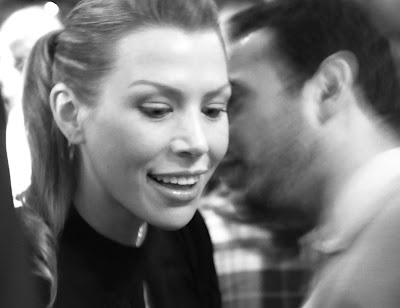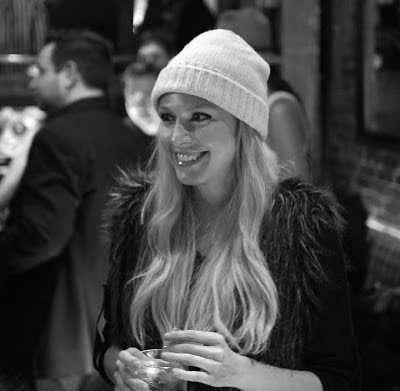Holiday Party? Shoot in Black & White!
(And Olympus E-PM2 & OM-D E-M5 Sample Images)
If you're going to a holiday party at a restaurant, bar or in someone's home, you're likely to encounter seriously low light conditions. Most people end up blasting everybody and everything with a flash, which not only ruins the ambiance, but often leads to less than flattering pictures. Don't feel like adding strobe effects to the party? Don't want overly orange or red photos (the result of the color temperature of indoor lights and longer exposures)? Consider going without the flash and shooting in Black and White.
If you were to just raise the camera's ISO to the now-available extremes of 6400 and above, you'll end up with lots of "noise" in your photos. But by shooting in Black and White, the "noise" is less noticeable, and you'll end up with some classic looking photos.
The trade-off of shooting without the flash is obviously much less sharp photos, but if you play around with various options and settings, you might be pleasantly surprised with the results.
Read on for some tips.
Set to Monochrome . . . or (better yet) Post-Process in Black and White
Option 1: Set your camera to monochrome. This is typically fairly easy, a selection under the menu functions of almost all digital cameras. The various ways of setting this is too broad to list here; if you cannot figure it out, I suggest Googling "setting (camera model) to monochrome."
By setting the camera to monochrome, you also get the added benefit of using up dramatically less information on your memory cards. So set your camera to the highest JPEG and RAW settings and fire away.
Option 2: You can also change color photos to Black and White shots after the fact in iPhoto, Photoshop or other post processing software programs. The benefit here is that you'll have many more options to choose from when switching to Black and White.
For example, you can apply various filters in Photoshop (e.g., go to Image > Adjustments > Black and White, and you can use presets such as blue, green or red filters that produce dramatically different results). Again, the options available are too numerous to list here, but it is very easy to process images taken in color and changing them to Black and White.
Boost the ISO
Next, bump up the ISO on your camera to a point you might not otherwise go near, such as ISO 6400. This will allow you to shoot faster shots in low light conditions.
Of course shooting at maximum ISO's will also add a great deal of "noise" to your pictures, which, in color, show up as fine, pixelated colored spots. Noise is definitely NOT the same thing as grain, which, in film days, added a certain character to photos. But for the purposes of holiday party photos, make the "noise" act a bit like "grain" by shooting in black and white. Purists will decry this of course, but most people will love the artistic feel of the black and white shots.
Shoot Wide Open
Set your camera to Aperture Priority (Av mode on Canons and A mode on Nikons and others). This allows you to select the lowest possible aperture setting, such as f/2.8 or f/3.5 (or, if you're lucky, f/1.4!), which in turn lets the most amount of light into the camera. The camera will set the speed for you automatically. Note that any speed less than, say, 1/30 of a second will require a very steady hand on your part, but it is possible to shoot even slower (with other caveats to follow below).
Setting the widest available aperture also reduces depth of field in your photos, so you get that blurry effect in the background, but also leads to somewhat "soft" focusing. Black and White photos make such soft focusing much more tolerable, and give photos an artistic touch.
Pick Non-Moving Subjects
Since you're likely to be shooting at relatively slow speeds, you must target non-moving subjects. People dancing and the like will show up as a blur. Instead, look around at table settings or people holding drinks and zoom in on their hands, which are likely to move a lot less than their faces!
If you do get the chance to take some portraits, have your subjects be as still as possible. Even in these conditions, you may get some relatively sharp and beautiful images . . .
(And Olympus E-PM2 & OM-D E-M5 Sample Images)
If you're going to a holiday party at a restaurant, bar or in someone's home, you're likely to encounter seriously low light conditions. Most people end up blasting everybody and everything with a flash, which not only ruins the ambiance, but often leads to less than flattering pictures. Don't feel like adding strobe effects to the party? Don't want overly orange or red photos (the result of the color temperature of indoor lights and longer exposures)? Consider going without the flash and shooting in Black and White.
 |
| Black and white shooting is great for still life shots. Olympus PEN E-PM2 with Panasonic Leica DG Summilux 25mm f/1.4 lens, 1/400 sec. at f/1.4, ISO 6400. Shot in monochrome on camera, some post-processing. |
The trade-off of shooting without the flash is obviously much less sharp photos, but if you play around with various options and settings, you might be pleasantly surprised with the results.
Read on for some tips.
Set to Monochrome . . . or (better yet) Post-Process in Black and White
Option 1: Set your camera to monochrome. This is typically fairly easy, a selection under the menu functions of almost all digital cameras. The various ways of setting this is too broad to list here; if you cannot figure it out, I suggest Googling "setting (camera model) to monochrome."
 |
| Shot in monochrome on camera, some post-processing. Olympus PEN E-PM2 with Panasonic Leica DG Summilux 25mm f/1.4 lens, 1/60 sec. at f/1.4, ISO 6400. |
Option 2: You can also change color photos to Black and White shots after the fact in iPhoto, Photoshop or other post processing software programs. The benefit here is that you'll have many more options to choose from when switching to Black and White.
 |
| Olympus PEN E-PM2 with Panasonic Leica DG Summilux 25mm f/1.4 lens, 1/160 sec. at f/1.4, ISO 3200. Shot in color on camera, post-processed to black and white. |
Boost the ISO
Next, bump up the ISO on your camera to a point you might not otherwise go near, such as ISO 6400. This will allow you to shoot faster shots in low light conditions.
 |
| A fun shot in extremely low light conditions. Shot in monochrome and no post processing. Olympus PEN E-PM2 with Panasonic Leica DG Summilux 25mm f/1.4 lens, 1/15 sec. at f/1.4, ISO 6400. |
Shoot Wide Open
Set your camera to Aperture Priority (Av mode on Canons and A mode on Nikons and others). This allows you to select the lowest possible aperture setting, such as f/2.8 or f/3.5 (or, if you're lucky, f/1.4!), which in turn lets the most amount of light into the camera. The camera will set the speed for you automatically. Note that any speed less than, say, 1/30 of a second will require a very steady hand on your part, but it is possible to shoot even slower (with other caveats to follow below).
 |
| Another good shot given the extremely low light conditions, shot wide open at f/1.4. Of course the image is a little soft, but it has a great look to it. Shot in monochrome and no post processing. Olympus PEN E-PM2 with Panasonic Leica DG Summilux 25mm f/1.4 lens, 1/60 sec. at f/1.4, ISO 6400. |
Pick Non-Moving Subjects
Since you're likely to be shooting at relatively slow speeds, you must target non-moving subjects. People dancing and the like will show up as a blur. Instead, look around at table settings or people holding drinks and zoom in on their hands, which are likely to move a lot less than their faces!
 |
| When you're not using a flash, you can sneak in photos without alerting your subjects. When shooting at lower speeds, focus on non-moving subjects. Shot in monochrome and no post processing. Olympus PEN E-PM2 with Panasonic Leica DG Summilux 25mm f/1.4 lens, 1/50 sec. at f/1.4, ISO 6400. |
If you do get the chance to take some portraits, have your subjects be as still as possible. Even in these conditions, you may get some relatively sharp and beautiful images . . .
 |
| Olympus OM-D E-M5 with Panasonic Leica DG Summilux 25mm f/1.4 lens, 1/15 sec. at f/1.4, ISO 3200. |

No comments:
Post a Comment